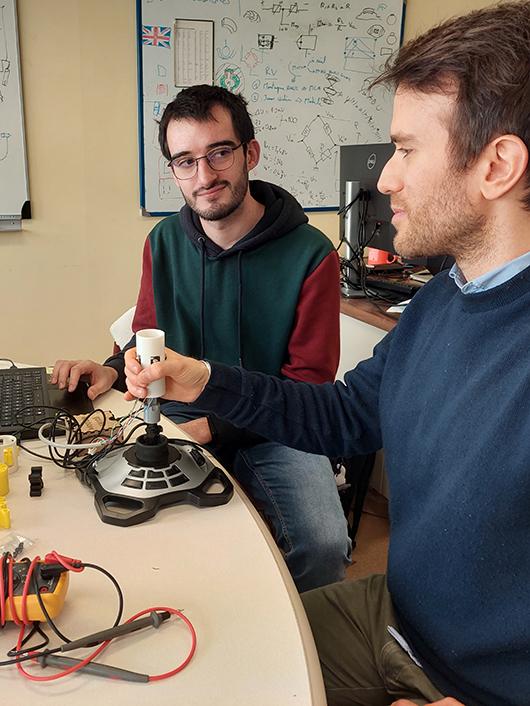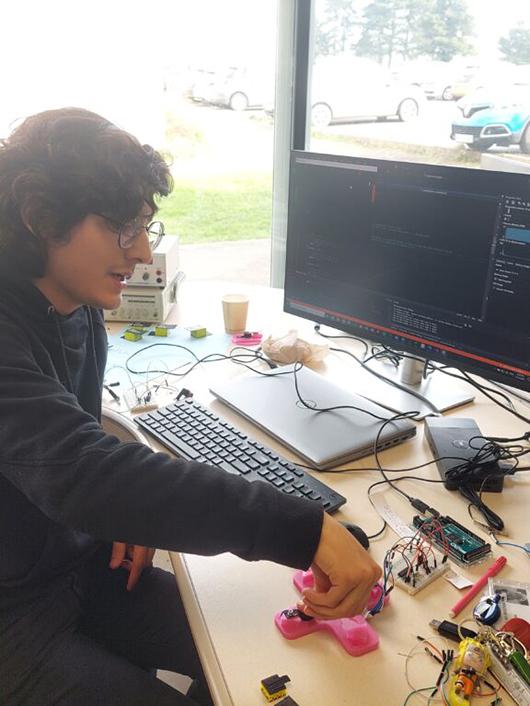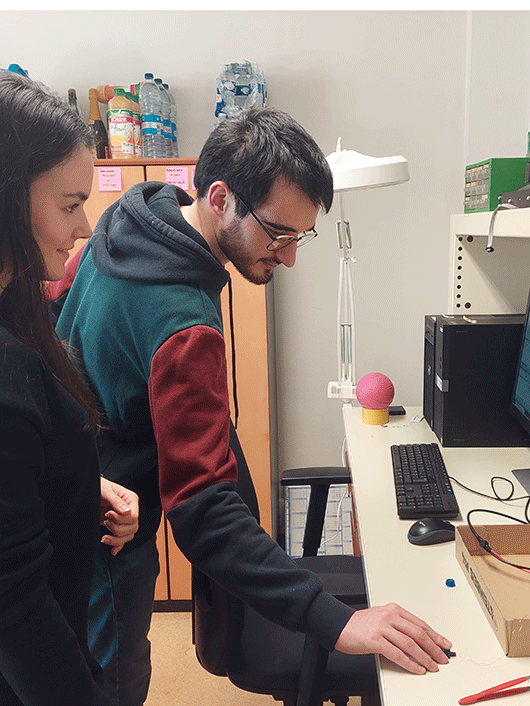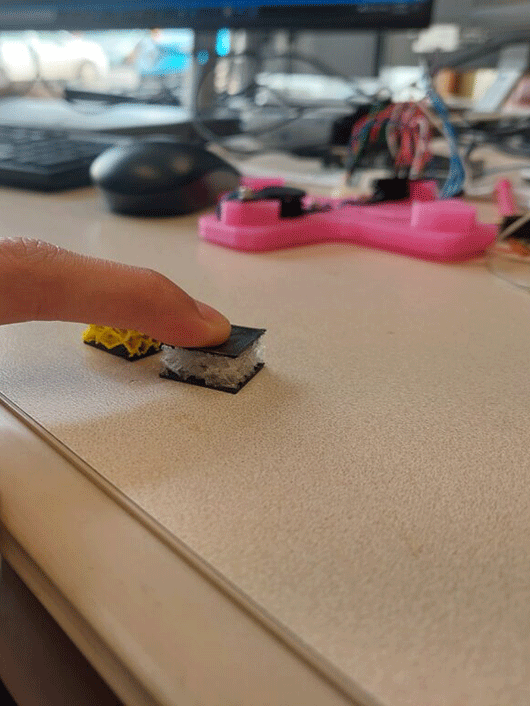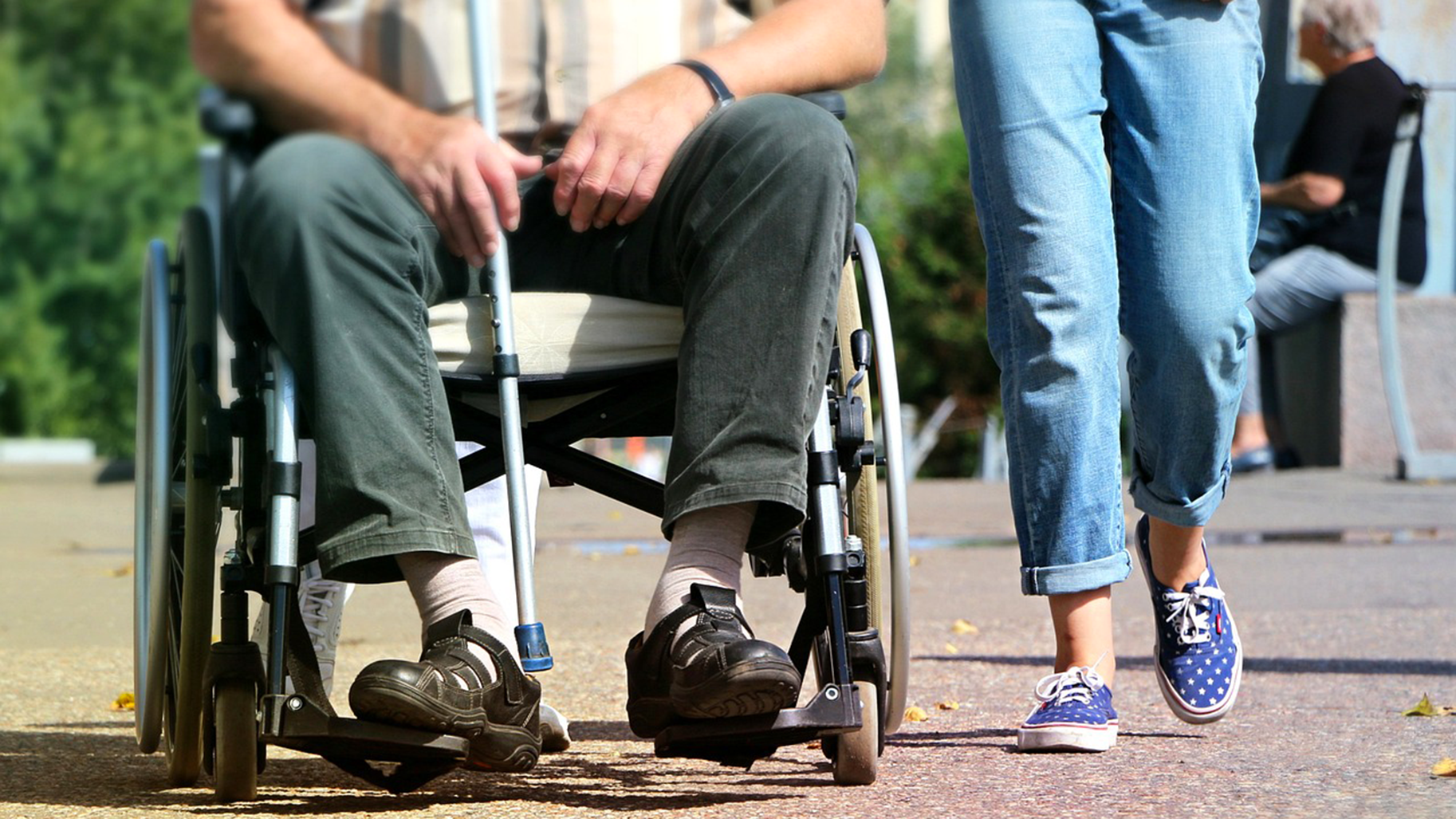
An experimental walking frame blocks the entrance to the laboratory. Simply take hold and close your eyes to understand how it works. Take your first steps in the dark...and the loss of bearings is immediate. Just a few metres forward and the handle starts to vibrate. Careful, you are about to hit a wall. Turn slightly to readjust the direction and move forward. Despite the lack of a visual references, steering is easy. And all the information is in the palm of your hand...
When we walk, touch is the sense we use least. This makes it available for sending messages to the person walking. Hence our idea to generate feelings on the skin with tiny vibrations to guide disabled people
says Marie Babel, who alongside Claudio Pacchierotti co-heads the INRIA Challenge Dornell, a transversal research initiative involving three of the Institute’s teams. A teacher-researcher at INSA Rennes and member of the Rainbow[1] robotics team, Marie Babel has worked extensively on steering aids for wheelchairs. The new technological brick will add haptic feedback to previously developed systems.
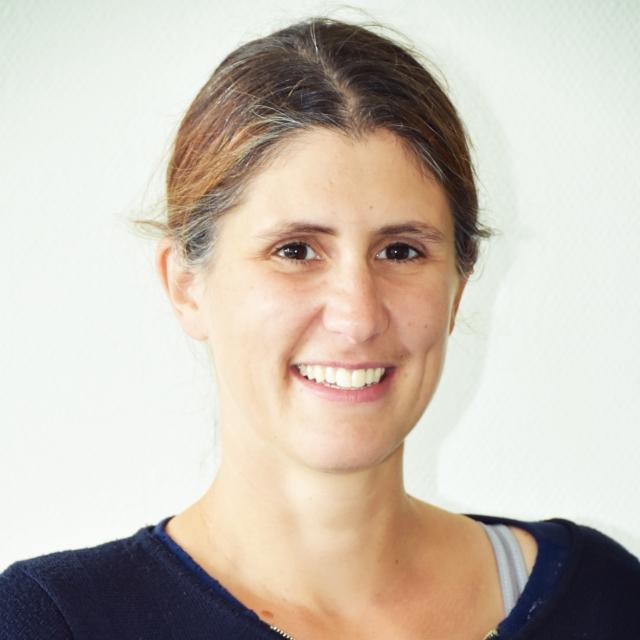
Verbatim
The idea was inspired by a meeting with researcher Pascal Guitton, from the Potioc[2] team, and an engineer who is blind. The device comes in the form of a smart handle which can be clipped onto existing equipment. By equipment, we mean technical mobility aids, such as the walking frame, white cane, pre-cane for young blind people, or electric wheelchair
teacher-researcher at INSA Rennes and member of the Rainbow Team project
Around twenty researchers, doctoral students, engineers and technicians are involved in the project. Their work required the design of several actuators. One of the systems developed is a joystick for steering wheelchairs. This joystick is equipped with four small motors. The vibration indicates the direction to take: left, right, forward or backward. The second device concerns the handle for canes and walking frames. Under thin plastic membranes in contact with the skin, a series of mobile magnets also produce tiny vibrations. Their design raises many questions: under which fingers should the membranes be placed? How strong should the vibration be? At what rate? Can we activate several membranes successively to indicate a direction, a little like a flashing arrow?
Issues linked to perception
Our research raises scientific issues linked to perception. What do we perceive? What do we understand of what we perceive? How do we interpret the signals? Based on this, how do we choose the best signal for a specific steering task? For example, is it better to have a system which vibrates to indicate an obstacle, or, on the contrary, to show the direction to take? Can we combine these operating modes? In addition to all this, it must be remembered that users sometimes have other sensorimotor or cognitive difficulties.
"For these perception aspects, our academic partner is the Institute of Intelligent Systems and Robotics (ISIR), and more specifically, the researcher David Gueorguiev, with whom my colleague Claudio Pacchierotti has already worked." The two scientists are currently co-supervising one of the theses funded by the INRIA Challenge, with Maud Marchal, teacher-researcher at INSA.
Including the user in the control loop
The project does not stop there, however. "In our work on robotics, we always try to include the user in the control loop. We thus thought that if the handle can send a steering signal to the user, it would also be helpful if this system perceived the state of the user in order to adapt the device use. Not just for the initial setting of the device, but on a regular basis during use. For instance, I can detect that the person is getting tired, so I may need to adjust the steering." Okay, but how do we detect this state of tiredness? "By working on the handle material. We thought it could sense the pressure exerted by the user’s hands and thus become bi-directional to send back information."
Innovative material to activate an electric current
This is where the third system under study comes into play, with the project’s third INRIA team: MFX[3] . "They work on 3D printing. They developed a material which can be compressed to activate an electric current and thus enable a command to be executed or to detect a level of pressure which may indicate a certain degree of tiredness. We’re currently testing ways to integrate this technology."
All this research is carried out "in collaboration with users, health professionals and care workers. It is based on continuous iterations: we go into the field. We test. We see what works and what doesn’t. We collect new ideas. We then return to the lab and implement them. We have two clinical partners. Firstly, the Institute for Blind Young People, Les Charmettes, in Yzeure near Moulins, where we work with a mobility instructor who provides us with a lot of information. Secondly, the Saint-Hélier Centre in Rennes, which manages a large physical medicine and rehabilitation centre in addition to several nursing homes. They are actively involved in this type of technological innovation.’ As a medical device, the handle will require specific certifications. ‘Our team has longstanding expertise in this field. For this project, for example, we have a dedicated engineer for these regulatory aspects."
Initial roll-outs in several establishments
What is the next step for this handle? "We usually go right to the pre-industrial prototype. When you are dealing with a system to control the electronics of a wheelchair, it is obviously the manufacturer who takes over. Things are a little different for the device we are developing this time, however. We can consider other distribution channels. Occupational therapists could use our equipment, for instance. We have also put files on open-source access in collaboration with the organisation My Human Kit in Rennes. This is a project backed by INRIA as part of an exploratory action [4]. This form of distribution is in keeping with the Denormandie-Chevalier report, submitted to the French Government in 2020, on the customisation of technical aids for disabled persons and the need to promote initiatives originating on the ground.’”
In this respect, clinicians are also the primary drivers of technological distribution. ‘We presented our walking frame during the French Society of Physical and Rehabilitation Medicine Congress (Sofmer), in Rennes last December. Rennes University Hospital is currently building one based on our open-source model. We’re planning to carry out a clinical trial together. Discussions have also begun with Brest University Hospital, in association with BEaCHILD,’ a scientific interest group devoted to paediatric rehabilitation.
A few prototypes are already in circulation. For instance, "at the Rey Roux paediatric centre near Rennes, a young man has been using his walking frame equipped with our device for more than a year. It has improved his quality of life. Before, he used to sit all the time. Now he’s walking about!"
[1] Specialised in visual servoing for robotics, Rainbow is a joint INRIA/IRISA project-team in partnership with CNRS, Rennes 1 University, and INSA Rennes.
[2] The Bordeaux-based Potioc team explores multimodal interaction, primarily in relation to virtual reality.
[3] The Nancy-based MFX team explores scientific issues in the field of 3D printing.
[4] This exploratory action is called Humanlab INRIA. This INRIA scheme facilitates the emergence of new research themes by providing scientists with the means to test original ideas.
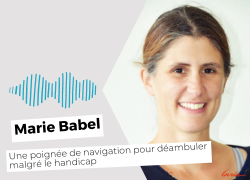
Know more about Dornell project with Marie Babel (french)

